Once I have my drawing on the paper ( Arches 140 lb, hot press), I start by reserving a few whites with masking fluid, and then I wait for the masking fluid to air dry.
Painting trees and leaves Watercolor Demonstration
I grew up in France but have been living in Canada for the last 12 years, I am currently located in North Vancouver and work from a studio on Pemberton Avenue.
Watercolor is my medium of choice because of the unique way it allows me to render light. The transparency of this medium can make it look like the painting is lit from behind and the light is shining through the paper In my portraits, I like to tell stories about the people around me. I am very interested in childhood fantasy or fairy tales (I wish it would snow Flowers, Hair Balloon, Georgia, the Spanish dress and the Eclectus Parrot). I also like to induce a dialogue with the viewer in some paintings dealing more with introspection and mood (Mixed, In the studio).
Those portraits are not about likeness or knowing the people that are being painted, as I see my models as actors in a movie, they are the faces that will allow me to tell a story or to show emotions. Those faces are a source of endless fascination and I find the subtlety that can be achieved with watercolor well suited to the complexity of the human face.
My technique involves the accumulation of many transparent layers of watercolor. Then I like to incorporate mixed media in the background, work sometimes with some contouring. I also sometimes like to add some drawing on top of the painting or some graphic elements…
Painting trees and leaves: On either side of the river, watercolor on paper
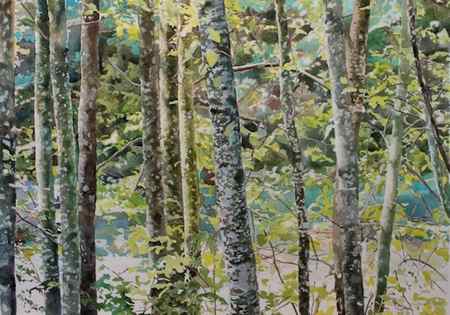
This is my latest watercolor on paper, I did paint it for the watercolor biennale coming up at the Federation of Canadian Artists in Granville Island ( Vancouver ). I had a few guidelines to follow : the size had to be 19 x 27 which is the size of the IKEA Ribba frame, most artists will use that frame so the exhibition looks more uniform. The painting had to be framed, these days I really like to mount my watercolors on board and varnish them but well, most watercolor societies and exhibitions won’t accept varnished or mounted watercolors.
Supplies:
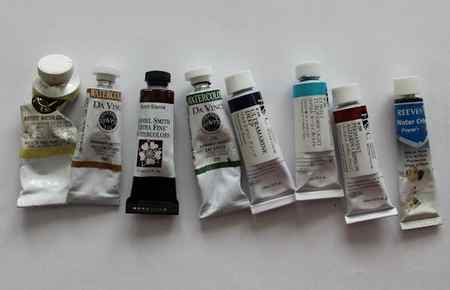
I am using a limited palette, Yellow Lemon and Yellow Ochre, Burnt Umber, Viridian green, Ultramarine blue, Cobalt Turquoise light, Permanent Alazarin Crimson and Paynes grey. With those colors I can mix an array of green, blue, and brown tones that will make most of the picture.
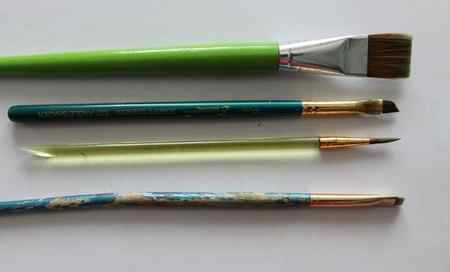
My favorite brush is an angular flat brush as I find it very versatile. I will also use a small brush for details like tiny branches, a large flat brush for larger washes like the trees trunk first layer of painting.
Finally I will use my old stiff brush for scrubbing off paint, it is a flat brush that i did cut shorter to make it very stiff.
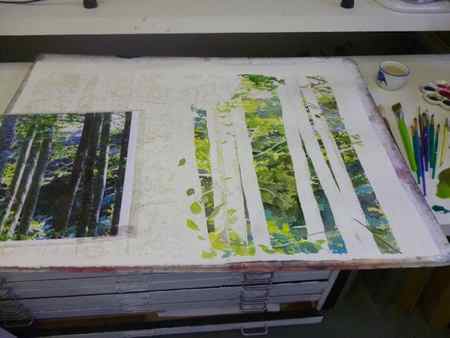
Once I have my drawing on the paper ( Arches 140 lb, hot press), I start by reserving a few whites with liquid frisket. I then start painting the background around the trees, starting from light yellow to darker greens. I also paint the few leaves in front of the trunks.
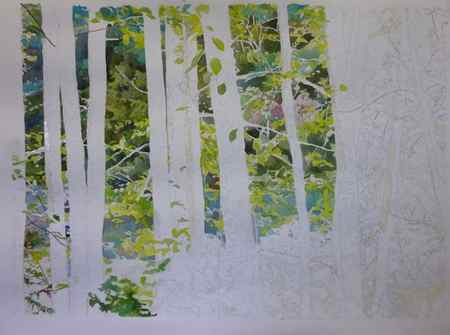
Working one section at a time I paint the background looking at my reference picture reproducing the tones of yellow, green, browns and the blue.
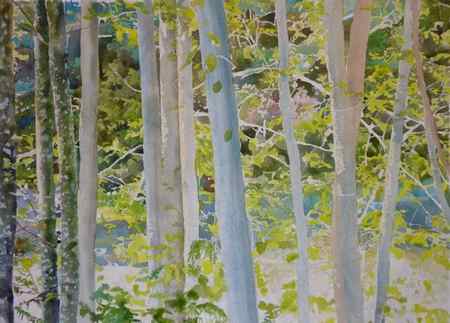
For the next step, I apply liquid frisket on the leaves I painted that are located in front of the tree trunks. Then I am applying a first wash on the trees trunks.
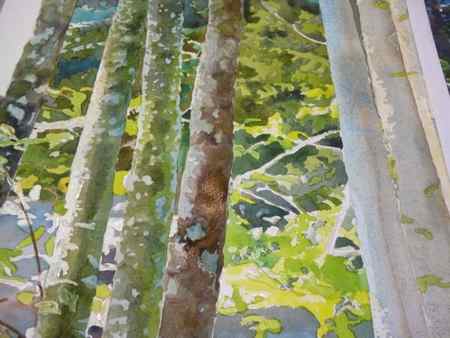
I then work on the bark of the trees, rendering the textures by scrumbling the paint.
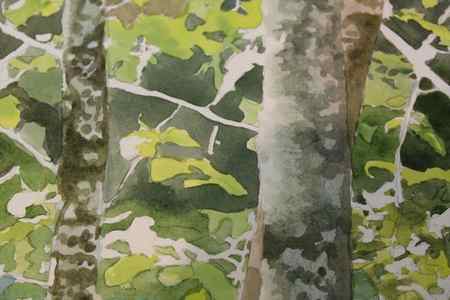
I am removing the liquid frisket, and will now paint the tiny branches
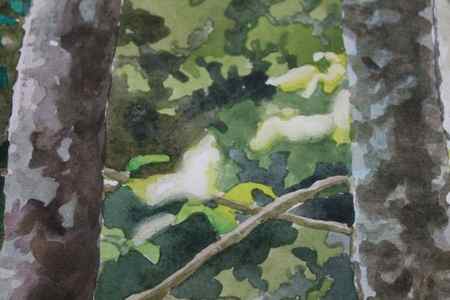
The next step for me is to soften the edges that were around the liquid frisket areas. Those areas will often have very hard unnatural edges. I soften most of those edges with my stiff brush and a bit of water
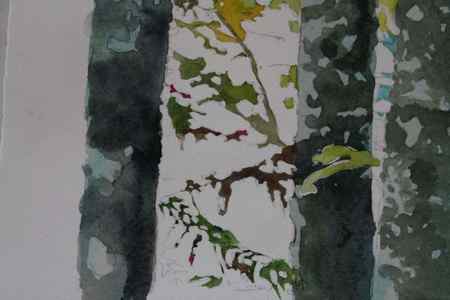
I am keeping some edges very sharp on the lower part of the painting to represent the light shining on the river water.
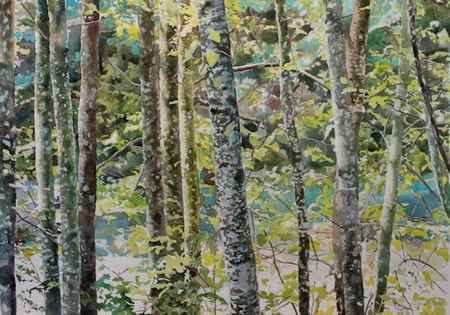
Watch the whole process on this time lapse video, in about 3 minutes.
“River Tree” Easy watercolor drawing Painting Challenge 6/300

For my sixth painting in the 300 Painting Challenge, I worked on an easy watercolor drawing of a landscape. Because my previous painting featured a very chaotic and abstract painting, I felt like painting something real and meaningful. It might sound weird, but I love trees. We don’t appreciate the trees to their right value.
So, I worked on a cool and easy watercolor drawing. I believe the painting is very easy, but you have to work a lot to make it look great. For this one, I used a regular watercolor palette. Maybe I am going back to basics with this school palette, but I believe this is somewhat giving me freedom. When I don’t have to focus on pouring color from the tubes and mix a lot of shades to get a certain color paint, I feel free to focus on the watercolor drawing.
Materials for our easy watercolor drawing
- paper (if you have watercolor paper is better)
- tape (optional, to keep the paper from changing shape as it absorbs water)
- a regular school watercolor palette
- various size brushes
- water
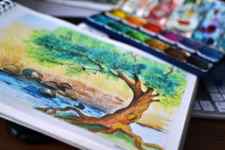
I have four brushes I use regularly for the watercolor illustration. A big flat brush that I use to dampen the paper with water. It’s useful for the wet on wet technique. Also, I have two round brushes with a pointy tip and two brushes very thin (These are the smallest numbers: 000 and 1 brushes). The last two brushes are extremely useful in adding details to your watercolor painting.
For my easy watercolor artwork, I began by adding water on paper for the wet on wet technique. I used a big brush to add color strokes that mix and flow on the wet surface.
Next, I use a hairdryer to dry the paint. After this, you will start adding shapes and details. Remember to always add the lighter spaces before the darker ones. If you want to lighten a space where you used a dark color will no longer be possible with watercolors. So be careful.
I try to plan my painting before I start working. For this tree watercolor painting, I analyzed the lighter areas: the yellow field, the sky, the bright green foliage and the color of the river. For this, you must apply the colors accordingly. Please, watch the video attached to this article to understand the process.
The harder part is to paint the leaves. I painted the light leaves and got darker and darker. After that, I began coloring the tree, the river details and the rest.
Conclusion
I promise this is a very easy watercolor painting if you have patience. Next, you can watch the time-lapse painting process. Also, I will be adding more watercolor painting on my youtube channel in the next days. If you like winter landscapes, you will love the next painting.
Thank you for watching!
Comments (21)
Drayton Hamilton
Dear Ms. Pelissier,
Many thanks for these demonstration videos; I think that with practice I will find them very helpful in getting away from trees with foliage that looks like vari-colored, flat and textureless cardboard cutout sheets of greens and yellows .
I have three related questions regarding frisket in your applications here as well as in others.
1. Can you suggest an alternative liquid to water as a medium for thinning frisket? I find that
if I want sharp, precise coverage when depicting small objects, especially with detailed outlines, frisket right out of the bottle often results in too imprecise and “blob”-like masks for my needs, and that frisket diluted with water is only marginally better in these respects, but at the same time is more likely to fail to resist the brushed over watercolor paint. 2. Is the alternative frisket- thinner that I wish for water resistant (to the water in the watercolor paint to be applied to it) enough to really do the trick even though it is — I hope — not nearly as thick on the paper as undiluted or water-diluted frisket? 3. If there is in fact such a thing as this non-water diluting and thin liquid for frisket, does one using it ever encounter chemical resistance problems in the mingling of the new diluter and the water of watercolor painting? For example, does the non-water frisket thinner dissolve, as may be imagined, into particles that spread in unwanted places on the paper? (Of course, this is not supposed to happen, but does it, anyway?) ///Thanks sincerely in advance for you knowledgeable responses to my questions. /// Drayton Hamilton, Montgomery, AL





